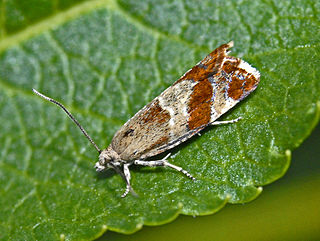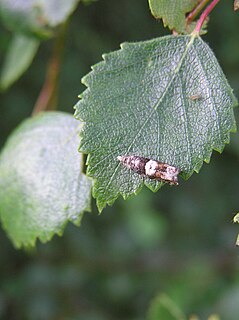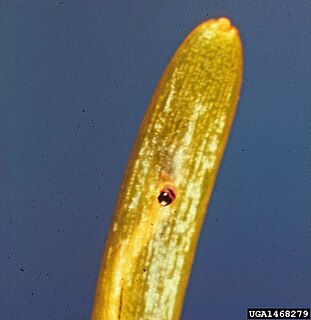
Cydia nigricana, the pea moth, is a moth of the family Tortricidae. It is found in Europe.

Epinotia immundana is a moth of the family Tortricidae. It is found in China (Qinghai), Russia and Europe.

Epinotia solandriana is a moth of the family Tortricidae. It is found in Europe, China, Korea, Japan and Russia.

Epinotia is a very large genus of tortrix moths. It belongs to the tribe Eucosmini of subfamily Olethreutinae.

The tortrix moth, genus Pammene, belongs to the tribe Grapholitini of the subfamily Olethreutinae.
Diplocalyptis is a genus of moths belonging to the subfamily Tortricinae of the family Tortricidae.

Epinotia cruciana, the willow tortrix, is a moth of the family Tortricidae.

Epinotia nanana, the European spruce needleminer, is a moth of the family Tortricidae. It is found from northern and central Europe to Russia and Mongolia.

Epinotia tenerana, the nut bud moth or alder tortricid, is a moth of the family Tortricidae.

Epinotia demarniana is a moth of the family Tortricidae found in most of Europe, east to the eastern part of the Palearctic realm.

Epinotia nisella is a moth of the family Tortricidae which is found in the Palearctic, Europe and North America. It was first described be Carl Alexander Clerck in 1759.

Epinotia meritana, the white-fir needle miner, is a moth of the family Tortricidae. It is found in the western United States, including Utah, New Mexico and Arizona.

Epinotia tetraquetrana, the square-barred bell, is a moth of the family Tortricidae. It is found from most of Europe east to the Near East and the eastern part of the Palearctic realm.

Epinotia trigonella, the birch epinotia moth, is a species of moth of the family Tortricidae. It is found in most of Europe, east to the eastern Palearctic realm. It is also found in North America.
Epinotia absconditana is a species of moth of the family Tortricidae. It is found in Australia, where it has been recorded from New South Wales and Queensland.

Epinotia subocellana is a species of moth of the family Tortricidae. It is found in Asia and Europe and was first described by Edward Donovan in 1806.

Epinotia abbreviana is a moth of the family Tortricidae. It is found in Europe and was first described by Johan Christian Fabricius in 1794.

Epinotia caprana is a moth belonging to the family Tortricidae. The species was first described by Johan Christian Fabricius in 1798.

Epinotia fraternana is a butterfly belonging to the family Tortricidae. The species was first described by Adrian Hardy Haworth in 1811.
















